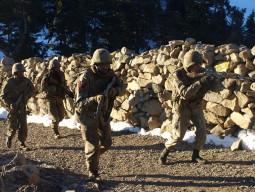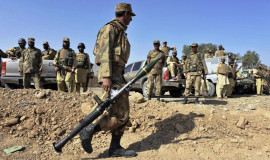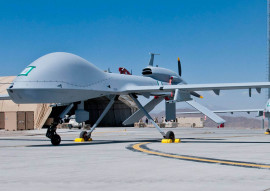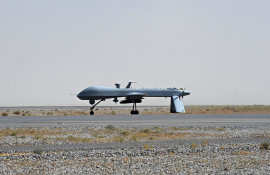
What happened at Mir Ali in North Waziristan Agency (NWA) last week was not an operation. It was a calibrated reprisal to the attack on an army post and convoy. The ISPR claimed eliminating over 30 Uzbeks and Turkmen, who had found residence there, and were culprits behind these dastardly acts. Hafiz Gul Bahadur, the chief of the militant group in control of the NWA, had warned people of the area to vacate immediately after Hakimullah Meshud’s death because of fears of similar reprisals for Taliban actions that were likely to ensue in the following days. Very few left.
According to a news report: “The foreigners residing in North Waziristan have multiplied the difficulties of their host tribesmen. People of Mir Ali are becoming bitter and inhospitable towards well-entrenched Uzbek fighters who were living in the neighbourhood(s) as paying guests.” This mix of part business and part mutual succour to sustain the business is what has skewed the dynamics of this war. Not only is the state guilty of tolerating foreign groups within its boundaries, it strangely has remained sanguine about these foreign groups providing a convenient shelter to militants — the state’s own direct threat that found its way into the NWA when flushed out of South Waziristan. The quid pro quo may have been the relative quiet of the NWA and the safety of Pakistan’s co-located military and paramilitary troops even as a conglomerate of militants lived alongside. It remains a complicated muddle.
It is important to understand the underlying dynamics that have resulted in this enigmatic calm. It began with the talk of a ‘hammer and anvil’ operation as a coordinated military effort to squeeze the space away from the groups that had entered Pakistani tribal regions after US operations in Afghanistan. Neither the hammer nor the anvil was in actuality ever enacted. The war against terror remained two separate wars; one fought in Afghanistan by the US/Nato, and the second within Pakistani territories as a combined mix of counter-terror and counter-insurgency operations. Pakistan maintained about 800 posts on its side of the Afghan border to check unauthorised movement across the border, while Nato/Isaf gradually reduced its presence to only 80 posts on the Afghan side. This mismatch of strategies and lack of coordinated action only bred mistrust and then distrust. Pakistan, as the junior partner, remained mostly on the reactive, waiting to see how the bigger actors in Nato/Isaf played their hand; what remained their intent, declared and real; were Pakistan to play by the apparent, would that suck Pakistan into greater harm; so on, and so forth. What seemed deliberate dither was, in fact, caution borne out of insecurity.
In the absence of transparent strategies and assurances that could alleviate Pakistan’s concerns, Pakistan developed its own play and its own timelines which, at the minimum, secured its own interests. Self-preservation became the defining need. Any notions of an offensive geopolitical design in Afghanistan became an irrelevant thought for a Pakistan that was consumed by its own complications. Other nations, such as India, the US and China found ‘strategic depth’ in Afghanistan instead. Pakistan considered it more appropriate to mind its own house and borders; a patently defensive mould.
What were Pakistan’s timelines? The following was assumed: when and if a peace process begins in Afghanistan, it will invariably result in the Afghan Taliban’s engagement with Kabul. As a spin-off, it could either encourage the militants on our side to follow suit, or, at the least, disconnect them from their nexus with the Afghan Taliban, as the Pakistani state pondered its options of a dialogue or an armed action. Either way, the militants and the Pakistani state will make their final choice; the militants separated from their larger umbrella, and the state freed from its dominating concern of unnecessarily sucking the full spectrum of militant presence in NWA, including those who have largely kept peace with Pakistan, and the Haqqanis, whose only focus has been Afghanistan. If, however, the state were to begin its operation in North Waziristan with the nexus between the two intact, the Afghan Taliban are certain to be sucked in the vortex. The state will still succeed with its immense potential, but would render itself to far greater strategic injury because of the ‘time’ and ‘effort’ it will need to give to a resulting consequence.
The Haqqanis populate four adjoining Afghan provinces on the Pakistan border. A war that includes the Haqqanis has all the potential of keeping alive on Pakistan’s western border even if the rest of Afghanistan and Pakistan have found peace. This unwanted war will keep Pakistan embroiled in debilitating operational deployments and operations on its borders, long after 2014 when all the rest have gone home. When it should have been the moment for Pakistan to fight its internal war against residual sentiment of radicalism, extremism and militancy in its societal midst, Pakistan would still be too engaged in finding peace on its borders. This would be a certain recipe of pushing Pakistan further back in time even as the rest find peace and spur along merrily.
That was the plan. However, a different dynamic and timeline is in play in Afghanistan. The peace process hasn’t even begun; courtesy the impasse between Hamid Karzai and the US over the Bilateral Security Agreement, and the politics of the upcoming April 2014 elections. In an unchanged strategic environment, the Haqqanis remain fixed in NWA, as does the nexus between them and other militants on the Pakistani soil. Any operation now will instinctively cause both to close ranks further and fight the war against Pakistan as a common war. That would be a strategic blunder. What has all this time been facing away from Pakistan would reverse course towards Pakistan. An operation in North Waziristan isn’t a simple proposition. There are strategic consequences that Pakistan will do well to heed. Pakistan must wait for the strategic context to change in Afghanistan before embarking on any elaborate operation in the agency. To that end, it needs to initiate engagement with Afghanistan and the US to trigger changes that will ease its own strategic options. Misconceived inaction behind poorly coined cliches — Afghan-led, Afghan-owned — has proven to be a sure recipe to deliver a stunted strategic context and threats that remain vibrant and undiluted.
Published in The Express Tribune, December 28th, 2013.
Like Opinion & Editorial on Facebook, follow @ETOpEd on Twitter to receive all updates on all our daily pieces.
COMMENTS (25)
Comments are moderated and generally will be posted if they are on-topic and not abusive.
For more information, please see our Comments FAQ

































































@mind control: @American: The alternative is to stay away from the foreign domain which is being guarded against tresspassers by two hunting dogs!
Rex Minor
@American:
That is the diagnosis which everyone is aware of.
What/Where is the prescription?
@mind control: There are only two possible outcomes...either you take on and subdue/kill the two hunting dogs OR you become the chicken and let the dogs eat you.....do you need more clues ?
In an unchanged strategic environment, the Haqqanis remain fixed in NWA, as does the nexus between them and other militants on the Pakistani soil. Any operation now will instinctively cause both to close ranks further and fight the war against Pakistan as a common war.
In short, the dilemma is "What do you do with a pair of hunting dogs that keep on biting you instead of hunting some chickens for you?'
The article does not offer any clues.
@American:
That window has closed - remember the American's have turned over combat to the Afghan's who are unlikely to cooperate with a country that has openly provided sanctuary to the Haqqani for over a decade.
@American:
Nail on the head!
MJ Akbar shares your opinion.
Watch this short clip.
@American: Fully agree with your analysis and the same was penned by me more than once on ET. However, the opportunity for a joint operation along with the Americans has already been lost, and there was never an intent for the same anytime in the past. The dark future predicted by you is going to become a stark reality soon.
Haqqani is committed and man of sacrifice. He sacrifices in what he believes. where as Pakistanis military Establishment is not ready to sacrifice in what they believe so they keep on changing their agenda and cause as the situation changes.
Can anyone cite an example where any other country has willingly allowed foreign militants/terrorist to occupy/control a large portion of their territory? Didn't think so. You can dress up/rationalize this action anyway you like but it still stinks.
@antanu: So is opium-induced slumber, pal! Forty years ago your kind did not think much of East Bengal. What do they think of you now?
I like writers like this one. All over the world, people toiling upward pause and glance back downwards to draw strength from their progress. In Pakistan, as the downward velocity increases, exhilarated scholars riding the skids glance over their shoulders at the heights, and write breathlessly about the heaven they are falling from.
".. Not only is the state guilty of tolerating foreign groups within its boundaries, it strangely has remained sanguine about these foreign groups providing a convenient shelter to militants.." That "state" was run by extra-terrestrials, no doubt. And none of them in uniform, of course.
".. It is important to understand the underlying dynamics that have resulted in this .." If you are still at the stage of assigning importance to understanding, I wonder when you will get to the understanding itself.
It is mysterious, isn't it? That animals you consciously bred would go for you rather than trek over mountains for weeks to get gunned down in a cruel foreign land?
Still, as the good Capt. Kirk would say, "Warp speed, Mr Sulu!"
@American:
You cannot even predict the future of Afghanistan and its neighbouring countries if you are not familiar with the history of this troubling region.Now there is no situation like 1980s, Pakistan is very much concernd with its internal crisis instead of Afghan's crisis or ISAF's departure. Dont jump to conclude by watching some intenational Pakistan specific news.
we are afghans not pakistani.and we will defend our land,stop dreaming to take afghansitan.every day you kill innocent pukhtoon..we all know your double standard game.frpm peshawar afghanistan.................................................
@American: day dreaming is bad for health bro. ..
Your window of opportunity for executing the hammer-and-anvil strategy is fast closing....and Pakistan has already lost 2-3 years while ISAF was strong and in strength in Afghanistan. After they are gone, the Afghans will join ranks with Taliban and seek strategic depth in Pakistan, if they haven't already. Serves you right..for naming your missiles after Afghan warlords....Pakistan is fast becoming ripe for an Afghan lead conquest..what an amazing turn f events...
The Haqqanis don't populate the four adjoining provinces in Afghanistan, they populate Miranshah with the blessing of the Pakistani establishment. Spinning ISPR narratives, old habits die hard.
If you don't go after your good terrorists, then don't expect things to change.
With due respects! Shahzad Chaudhri sb we know that ISPR have already a Spokesman, You are 500 mile away from reality and waziristan becuse you had mantion that [ It was a calibrated reprisal to the attack on an army post and convoy}.If you have some time pls visit to LRH Hospital Peshawar maybe you will found injured housewife under 15 students.....
"Pakistan’s co-located military and paramilitary troops even as a conglomerate of militants lived alongside."
Now that you have put it like that ..what can I say? Its same as crows and buffaloes being co-located in the same jungle (unlike snakes and mongoose)
I wonder why Pakistan's Military even needs to be present at the border posts ...It can come back after the peace process starts/ends in Afghanistan...unless you are spinning Pakistan's dismay performance/resolve (or lack off it) against terrorists.
That for a layman was quite complex but yet understandable.
Emasculating Afghanistan for reasons of "strategic depth was and is Pakistan's very active policy. Nothing defensive about it. It never focused on minding its own house and borders.
Shahzad Chaudhry Sahib:
Many months ago when you were writing in support of Hafiz Saeed, I used to criticize your columns. Now, I am happy to see the change in your articles and appreciate it. I support your views and your support for the strong military action to wipe out the terrorists.
Let me add here that one of your own, the Retired DGISI, Hamid Gul is against your views. I have watched you on recent TV debates, politely opposing his views. As I see it, he is openly supporting the talibans and terrorists that you want them to be wiped out. His subliminal messages may incite revolt in the army ranks and this is one thing you should watch closely and counter strongly. He has the support of Imran Khan and Sheikh Rasheed. In a recent TV debate, Hamid Gul was very critical of the army action in NWA.